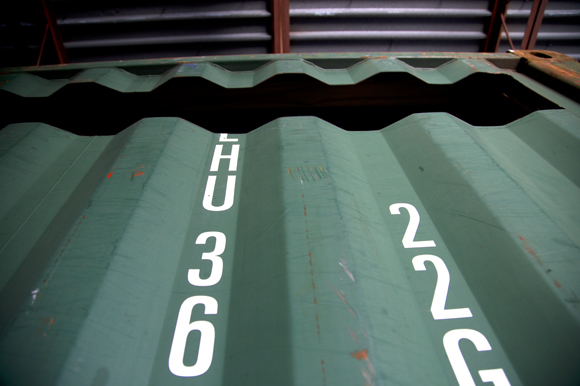Shipping containers encourage innovative, creative designs for living
Shipping containers built to sustain high winds and heavy rain as they cross the oceans are being repurposed into affordable, sustainable homes and shops in Tampa and St. Petersburg.
Just a few years ago, container homes were a novel concept found mainly in Europe and on the West Coast of the United States. But, if OT9 Design architect Sean Williams has his way, container homes may soon be popping up by the dozens throughout the Tampa Bay region.
“It’s calculated pioneering,” says Williams of his efforts to build what would be among the first container homes in the Bay area. Williams has more than a decade of experience in the architectural industry and is an expert on Leadership in Energy and Environmental Design (LEED), or green building principles. So, entering the arena of sustainable home construction seems like a natural fit for the renowned St. Petersburg designer.
“It’s upcycling found objects – shipping containers – into something that can be used for a good purpose,” he explains. Though in this case, Williams and his team didn’t simply find these old containers. Rather, they bought the 20- and 40-foot-long corrugated metal freight cartons from brokers who acquire the containers after they’ve reached the end of their useful life aboard cargo ships zigzagging the world’s oceans.
Williams estimates that, around the United States, there are 25 to 30 million unused shipping containers just like the ones he is transforming into homes. The empty sea containers can stack up by the hundreds in port cities where they sit abandoned, often because some shipping companies can’t afford to return the emptied metal cartons to their points of origin.
The containers, which on average cost between $3,000 and $7,000 to buy from a broker, can be turned into modular homes that now sell for around $65 per square foot. Williams predicts that cost will drop by half as the building techniques become more standardized on a larger scale.
“We’re really aiming to market these container homes to people such as recent college grads, who may be saddled with student loan debt and want to buy an inexpensive home that is conveniently sized for their needs,” Williams says. “With a container home, you can easily add on for future use.”
In fact, in the construction sense, it’s possible to stack the shipping containers seven tall – effectively creating a seven-story building.
Turning a shipping container into a home
At first glance, the empty shipping containers may not look like more than simple steel boxes. But within a single steel container, Williams sees a comfortable studio-style home with ample space for a kitchen and a bathroom. Adjoin two or three containers, and suddenly the bachelor pad space becomes a perfect nest for a newlywed couple or a growing family.
General contractor Brent Patterson, who finishes each container, says it could take a few weeks to complete the interiors, but “they can be assembled onsite in as little as two days.” While the team can provide standard interior designs, the homes can also be custom built to suit the unique needs of the buyer.
Cuts in the corrugated steel exterior of the boxes allow for windows and doors, and attaching several containers together, either side by side and/or on top of the other, can provide the square footage that the homebuyer wants.
“As long as we don’t cut into the container’s primary structure, then the containers can be easily expanded beyond their 8 foot width. They can even have roof decks,” Williams explains. “There are no limitations.”
While the upcycling aspect of the containers themselves represents a huge leap forward in sustainable construction, the green angle of these unique homes doesn’t stop there.
“We use R-20 foam insulation and a paint that also acts as a thin insulation,” Williams explains, saying the homes will use energy-efficient technologies to protect occupants from Florida’s blisteringly hot summers. “We’ll also use energy-efficient windows to help reduce energy consumption and keep heating and cooling costs lower.”
“The goal is net-zero energy usage,” Williams says. “We’ve even considered equipping these homes with solar panels, though they are relatively expensive to buy and install at this point.”
Still, the versatility of the container homes could allow for further energy-efficient improvements to be made as the cost of these technologies continue to inch downward.
While the natural look of the corrugated exterior can make an architectural statement by itself, some homeowners may prefer a façade that looks more like a traditional housing structure. Williams’ team says exterior upgrades can be completed for clients who want such modifications.
Container homes built to last
While the concept of container homes might conjure up images of more traditional manufactured housing, Williams says container buildings are inherently stronger than many of the more conventional modular home structures on the market today.
“[The shipping containers] are designed for ocean travel, and they regularly survive the trip across rough waters, heavy wind, salty air and other elements they’re exposed to on ships,” he says.
William adds that the container homes are in the process of being officially wind tested to ensure they pass all necessary local hurricane codes. He’s also working on getting approvals from St. Petersburg City Council to build the homes in the city’s neighborhoods.
“One of the things that Council members are trying to determine is if these container homes should be legally defined as manufactured homes or custom homes.”
While Williams envisions his container homes being built on standard residential lots in typical neighborhoods, he admits that the relatively young container home industry has faced some hurdles when trying to obtain building permits.
“Land development regulations make it hard to build in historic neighborhoods,” he says. “We’re having conversations with the city [of St. Petersburg] on coding regarding where they are appropriate to build.”
He believes the container homes are one possible solution for local affordable housing initiatives. “These homes are being designed for single-site installation for the most part, but perhaps a ‘container community’ could be built in a gentrifying neighborhood.”
Other container buildings popping up
While Williams’ container homes are on the verge of providing new housing options, Brandon Hicks is mainly focused on providing commercial interests with similar sustainable construction opportunities.
Hicks, the principal architect who, along with colleague Rick Penza, founded Twelfth Street Studio in 2010, has overseen a number of commercial projects in the Tampa area. One of his recent highlights is the container installation at The Getaway tiki bar restaurant on the Pinellas side of the Gandy Bridge.
“This project had a unique set of circumstances that aligned nicely for the use of containers to house their kitchen and bar, including a limited area for the project’s footprint and maximizing the site by building over an existing retention pond,” he says. “From a design standpoint, the use of the container supplemented the atmosphere The Getaway has developed while also referencing the rich shipping and maritime history of the Tampa Bay region.”
Hicks says that the coding process has not been a major hurdle for his commercial projects. Though local government officials are often “skeptical at first,” he says, they become “curious and fairly open-minded about their use,” once they learn how durable and versatile the shipping containers are. “Once everyone moves beyond the fact that it’s a container, then it becomes just another building – the engineering, code requirements and other regulations are applicable in the same manner as traditionally designed projects.”
Many of the prospective clients Hicks encounters are looking for simple, inexpensive and fast solutions for a garage, house or other accessory structures, but often they cite a “coolness factor” as one reason they pursue a container structure. “The concern is that this tends to suggest that this construction is a trend and will pass. We maintain that, sure, we can make it ‘cool,’ but [also] how we can leverage the qualities of the container to solve other issues through their design.”
Often, the discussions will springboard into the common uses for container structures, including temporary classrooms, emergency operation centers and temporary housing in disaster areas. “Sometimes this energizes the client and sometimes it drives them away, [but] either way we’ve had a great discussion and sometimes that’s more important because, in the end, either they want to do this or they don’t. The discussion acts as a good vetting process in this regard.”
Next wave of the future?
As Williams guides the construction process of his container homes in a St. Petersburg warehouse and Hicks leads his projects from a home base in Tampa, the future of the container building industry looks promising on both sides of Tampa Bay.
While St. Petersburg has The Getaway, Ferg’s Live restaurant across from Amalie Arena in Tampa installed a handful of containers late in 2014 to create a bar, restrooms and a band shell.
Meanwhile, shipping containers are getting a second chance at life in other cities around the nation. Up Interstate-75 in Detroit, Michigan, a company called Three Squared is building a container home project that was first proposed in 2008. Elsewhere in the Motor City, a 36-room boutique hotel called Detroit Collision Works [http://detroitcollisionworks.com] is being built as funding and support comes together.
Earlier this year, Mexican-inspired fast food giant Taco Bell unveiled plans to build some of its restaurant locations from shipping containers, which can be constructed in as few as three days. But Taco Bell isn’t the first nationally recognized restaurant company to construct facilities from shipping containers.
Since 2011, coffeehouse chain Starbucks has opened several drive through-only container-built stores in communities such as Chicago, Salt Lake City, Denver, and its headquarters city of Seattle. No doubt, plans for more of these container structures are brewing elsewhere.

















